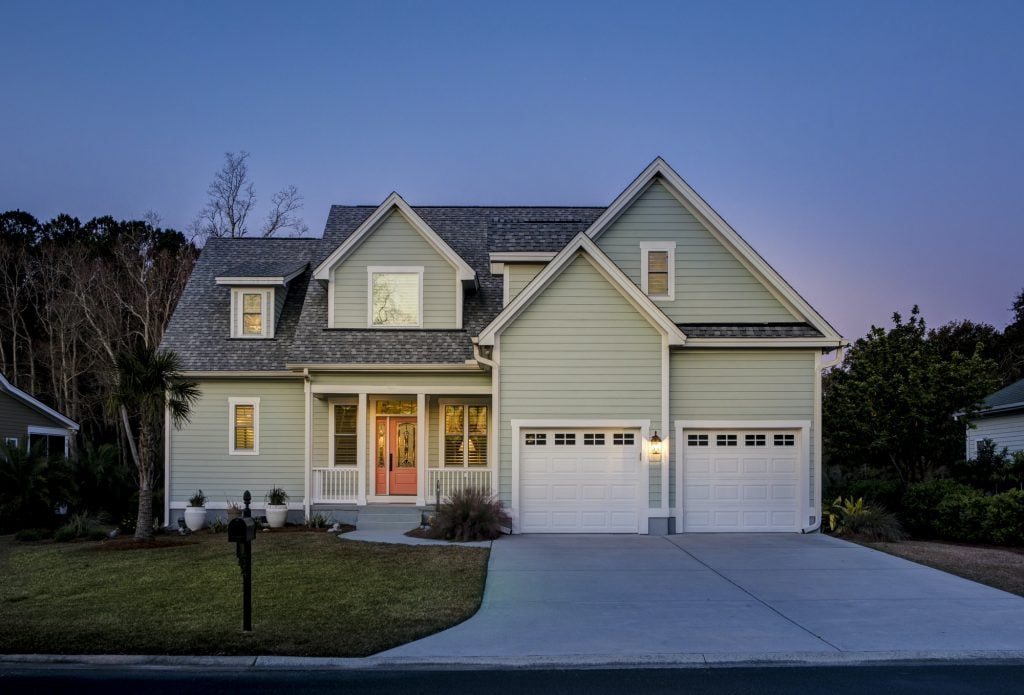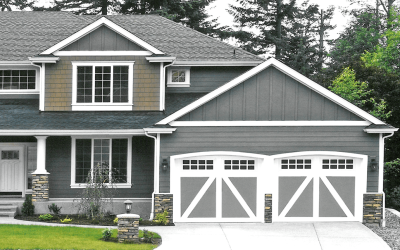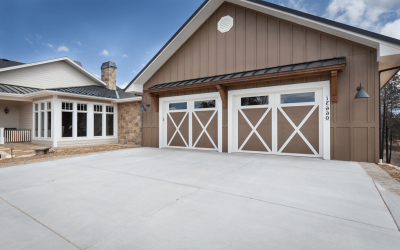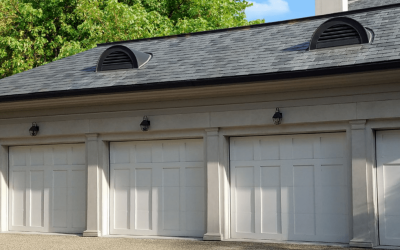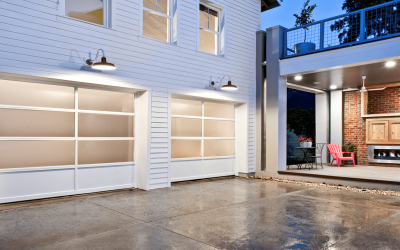One-Piece Curtain Door Torsion Springs
Operating much like steel rolling doors, one-piece curtain doors are usually found at self-storage locations. The industry has two names for these particular doors, self-storage doors and mini-warehouse doors. The height and width of these curtains do vary greatly.
Mini-warehouse doors are rolled by manufacturers from a single piece of steel. Because interlocking slats are used to form the curtain on steel rolling doors, these mini-warehouse kind of doors consist of single-piece curtains. When the door is opened, the curtain begins wrapping around the drums, which in turn are attached to the shaft. Because of the design of this door, what is known as one-piece curtain doors can also be called steel rolling doors or roll-up doors.
Circular drums are spaced along the axle on these doors. These drums are used to help support the door’s curtain during opening and closing. In this scenario, torsion springs are attached to the outer most drum with a bolt. Usually two torsion springs are needed to balance the door with one being placed on each end of the shaft. The opposite end of the torsion spring is connected to the door bracket, which is located on the other end of the door. There is an axle that passes through the bracket, the drums and through the center of the torsion spring.
Manufacturers, including Trac-Rite and Janus, have garage doors that feature a tension adjustment wheel. This adjustment tool is not found on the doors of some manufacturers, such as DCBI. Doors that do not have tension adjusters have visible springs when the door is open. The garage doors that are equipped with tension adjusters have drums that have steel wrapping, thus hiding the springs from view.
Garage Door Extension Springs
Most often, garage door extension springs are mounted above the horizontal tracks along the sides of the garage door. These springs are designed to contract and stretch as the door is operated so they can help counterbalance the door’s weight.
In general, residential garage doors have two extension springs. One spring is placed on each side of the garage door. Some residential garage doors, as well as commercial and industrial garage doors, require more than two extension springs. In some instances, they have multiple springs installed on each side of the door.
Extension springs have different designs. These springs have closed loops or open loops or clipped ends that are used as a way to secure the spring to the spring to either the pivot pin, frame or tension adjusting bolt, track hang or pulley.
Sectional Garage Door Extension Springs
The most common kind of extension springs installed on garage doors in the United States are sectional garage door extension springs. Stretching above and parallel with the horizontal tracks on each side, these springs can counterbalance the garage door by pulling on the door’s cables. Upon the closing of the door, the cables tack on the weight that is transferred from the tracks. The process results in the door becoming heavier, as the springs stretch and pull against the cables in order to balance the door and make operating it proceed much more easily.
More often that not, residential garage doors require two springs. One spring is put on each side of the garage door. When looking at the springs, you will see that one end of each spring connects to an open-eye bolt. This bolt is most often attached to the angle iron that holds to the track or to a beam that is part of the garage frame. Usually, a pulley attaches to the extension spring’s opposite end, but it requires the help of a pulley fork to do so. One cable end that goes over the pulley is attached to what is called a cable adjustment clip. An S-hook attaches to a horizontal track and the cable adjustment clip. The cable’s other end rolls over the second pulley then down below to a bottom fixture located on the garage door’s bottom section.
Industrial and commercial overhead garage doors are designed with an extension setup that looks very much like those for residential garage doors. The doors that are heavier may incorporate the use of a special kit that connects the ends of multiple extension springs. With this special kit, multiple springs can be stretched simultaneously on each garage door side. While not every industrial and commercial garage doors have this particular setup, the rest use a single extension spring on each side of the garage door. In general, they work much like residential doors. Supplying the lift in both kinds of garage doors, commercial pulleys are significantly stronger and can lift doors that are heavier while not breaking prematurely.
One-Piece Garage Door Extension Springs
As indicated by the name, one-piece garage doors function as one large piece. Upon the opening of the door, the top moves to the inside of the garage as the bottom moves outside. In this instance, the extension springs pull against a connecting point or a pivot pin in order to counterbalance the door’s weight. Because of the door’s design, it is not possible to weather-strip. These doors are usually found in gentle climates where the weather-stripping is not needed.
Extension springs are used by one-piece garage doors. These springs help counterbalance the door. With one or two extension springs placed on either side of the door, these kinds of doors have two or four springs in order to operate. An adjusting bolt, which is fastened to a door jamb bracket, is where the bottom of the spring is attached. Stretching upward, almost perpendicular to the garage door, these springs are attached at the other end to a lever arm that is attached to the garage door. Upon the garage door opening, the spring loses some of its stretch and shortens.
Torsion Spring Hardware
There are several pieces of hardware that works with garage door torsion springs. This hardware includes winding and stationary cones, cable assemblies, spring anchor brackets, and spring blocking. All are very integral parts of a garage door except for the spring blocking, which is used in industrial and commercial environments primarily.
Spring Anchor Brackets
What is a spring anchor bracket? It primarily connects the torsion spring’s stationary cone to the garage door header. This bracket must be tightly secured to the header in order to prevent the tension in the spring from spinning the bracket loose. The spring anchor bracket is determined by basically measuring the distance between the garage header to the shaft’s center, or measuring to what is known as the center line. End bearing plates are needed on larger cable drums.
While there are slotted spring anchor brackets, which makes the replacement process move much more easily and more quickly. Those brackets that are not slotted can double as idler brackets as well as spring anchor brackets. When used as idler brackets, they are used to help support the shaft if the garage door has additional weight on it.
Torsion Spring Cones
A stationary cone is used for every torsion spring. This cone keeps the spring end from moving. At the other end of the torsion spring is a winding cone, which is designed to hold the spring onto the shaft. This cone’s goal is to apply tension to the shaft and in turn, supply the lift to the garage door.
Cones for torsion springs are based primarily on the spring’s inside diameter. As an example, if a torsion spring cone has a diameter of two inches, it can’ t be used with springs that are smaller than two inches or larger than two inches. The wind is also an important aspect of spring cones. A right wind cone goes with a right wind spring, just like a left wind cone is for a left wind spring. There are dual wind cones, which can be used with either kind of springs.
Spring Blocking
When used for heavier commercial and industrial applications, torsion springs have larger diameters inside. To prevent the sagging of the spring and to keep it from resting on the shaft, there is blocking inside the springs. This blocking slides over the shaft, and then it fits inside the spring where is located between the stationary and winding cones. PVC blocking is used with springs that measure from 5-1/4″ to 6″ while wooden spring blocking is used with 7-5/8″ springs. The measurements are based on interior diameter.
Garage Door Tracks and Garage Door Track Hardware
Housing as well as guiding the rollers, garage door tracks help facilitate the garage door’s smooth travel. There are several articles on this site that will help you learn more about garage door tracks and learn more about how to select the best hardware for your particular door.
Garage Door Track Sizes and Characteristics
Galvanized for added protection against corrosion and rust, garage door tracks are an essential part of a garage door’s operation. Earlier tracks were made with raw steel that was just covered with a coat of black paint. In general, vertical tracks range in length from six-foot four inches deep to 14 feet four inches deep, mostly in graduations of 12 inches.
Three widths are available for garage door tracks. These widths range from one inch to three inches. Most commonly used in truck and semi-trailer door environments are one-inch tracks. Most residential garage doors and commercial garage doors require two-inch tracks. The heavier garage doors and commercial doors require the support and guidance of three-inch tracks.
Tracks for residential doors usually measure one of three thicknesses, 0.055, .062 or .075. Track thickness has been reduced in thickness in recent years, particularly because of the switch to lighter weight steel doors. According to old standards, the traditional thickness for heavy wood doors was 0.075 inch. Before that, the standard track size came in at 0.083 inch. As a standard, three-inch tracks are made with steel that measures .109 inches.
The majority of garage door tracks are now made by Napoleon or Arrow Tru-line. In the past, all garage door manufacturers made their own tracks. A few, including Wayne Dalton, Overhead Door and Raynor, continue to make their own today.
Garage Door Track Lift Types
There are three kinds of garage door track lifts, standard lifts, high lifts and vertical lifts. For most residential applications, standard lift tracks are sufficient. Consisting of a vertical track, which reaches to about eight inches below the height of the door or six feet and four inches with a curved section that turns back toward the rest of the horizontal track. Working together, these sections permit the door sections to lift and then move into a horizontal position above the floor of the garage.
Many industrial and commercial garage doors use vertical lift systems, which are formed from a track that rises vertically just like the standard lift, but also incorporate the use of an additional vertical track that is pitched away from the door’s interior wall, sometimes reaching a distance of one-foot to a foot-and-a-half. The extra space is ample enough to allow the spring assembly. At points on the extension, the widening distance is spanned by brackets.
A vertical lift and a standard lift are combined in high lift systems. Featuring a vertical track, they have a shorter horizontal track than the standard lift system. A high lift extension varies in length, dependent upon the application and the individual needs of the one using the system. If a residential garage had a ceiling that reaches about 12 feet in height, this particular extension can measure about four feet. The residential setting can either start with a high lift system or what is known as a conversion kit for high lifts can be used to convert the garage door to a situation that has a higher lift. These kits have gained popularity in recent years.
When used in a commercial setting, the track’s extension portion may rise up to a height as tall as the door itself, only curving horizontal near the ceiling. This option can be considered a viable alternative to using a vertical lift in situations that are considered low-space.
Rate this page



